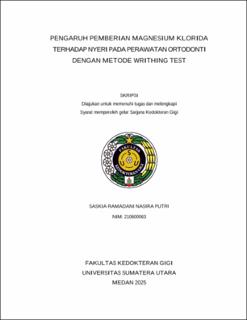Pengaruh Pemberian Magnesium Klorida Terhadap Nyeri pada Perawatan Ortodonti dengan Metode Writhing Test
The Effect of Magnesium Chloride Administration on Pain in Orthodontic Treatment Using the Writhing Test Method

Date
2025Author
Putri, Saskia Ramadani Nasira
Advisor(s)
Lubis, Mimi Marina
Metadata
Show full item recordAbstract
Pain in orthodontic treatment is related to inflammation and stimulation of the free nerve endings in the periodontal ligament due to the application of mechanical forces to the teeth. This pain typically appears within 2-4 hours after separator placement, peaks within 24 hours, and gradually subsides over 3-7 days. Magnesium is a mineral known for its analgesic effects by blocking N-Methyl-D-Aspartate (NMDA) receptors located on postsynaptic spinal neurons in the dorsal horn of the spinal cord. Magnesium chloride (MgCl2) is a highly water-soluble form of magnesium salt, commonly used as a magnesium ion source due to its easy absorption by the body. This study aims to investigate the effect of magnesium chloride administration on pain during orthodontic treatment in Wistar rats using the writhing test method.
This study is a laboratory experimental study using the writhing test method on 21 male Wistar rats, divided into three groups with observation times at 2 hours and 24 hours after separator placement. The control group received no magnesium chloride and no orthodontic rubber separators, the first experimental group received no magnesium chloride but had orthodontic rubber separators placed, and the second experimental group received magnesium chloride and had orthodontic rubber separators placed.
The results showed that the second experimental group had the lowest average pain response, with 4.86±2.67 writhes at the 2-hour observation time and 8.57±3.78 writhes at the 24-hour observation time. Data were analyzed using ANOVA and post-hoc LSD tests. The results demonstrated a significant difference in pain responses between the control and experimental groups at the 2-hour observation time, whereas no significant difference was observed at the 24-hour observation time. In conclusion, magnesium chloride has an effect in reducing pain in Wistar rats with orthodontic rubber separators during the first 2 hours, based on the writhing test method.
Collections
- Undergraduate Theses [1908]
